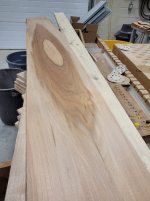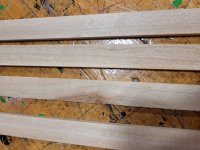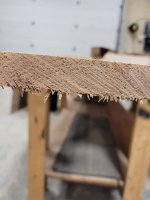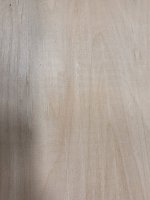So I'm teaching woodworking again, probably going to build a canoe with the senior class. I have three massive pieces of wood I can't identify. Two are 14 feet long, 22 inches wide and sixteen inches wide, the other one is the one in the picture. Clear, no knots, lighter than hardwood, heavier than cedar, planes very easy, like a softwood. No idea what it is. Any experts out there?
-
Happy Opening of the Maine Turnpike (1947)! 🛣️🦞🌲
You are using an out of date browser. It may not display this or other websites correctly.
You should upgrade or use an alternative browser.
You should upgrade or use an alternative browser.
Wood identification.
- Thread starter memaquay
- Start date
Is it from a local source or did it come from away? That might help. I can’t help from that pic, but if you can take a closeup of the end of the board. Ideally plane a section of the end so you can get a good view of the growth rings.
I might be able to find it in a book I have.
Jim
I might be able to find it in a book I have.
Jim
I'm no expert but my guess would be cottonwood.
Hard to tell by the pic. Is there wane at the end of that board? If so is there any bark left on it? That could help.
In addition to cottonwood the others that first come to mind are soft maple or basswood.
Cottonwood and basswood both have distinctive smells when machined (especially sawn). Cottonwood often fuzzes on the surface a little when machined. Basswood smell is hard to explain. Not really pleasant but not unpleasant either. Most people find cottonwood smell unpleasant. It almost always smells burnt when ripping on a saw.
Like Boatman mentioned a close up of the end grain would be helpful.
The wood database is a great resource:
 www.wood-database.com
www.wood-database.com
Alan
In addition to cottonwood the others that first come to mind are soft maple or basswood.
Cottonwood and basswood both have distinctive smells when machined (especially sawn). Cottonwood often fuzzes on the surface a little when machined. Basswood smell is hard to explain. Not really pleasant but not unpleasant either. Most people find cottonwood smell unpleasant. It almost always smells burnt when ripping on a saw.
Like Boatman mentioned a close up of the end grain would be helpful.
The wood database is a great resource:
Wood Filter | The Wood Database
Alan
In addition to the above, is there any sapwood on any of the pieces? (Perhaps the white bit in the center of the pictured plank?)
Also, how's the color reproduction in the picture? Some (most) cameras do some automatic white-balance adjustment, so colors get skewed.
My first thought was butternut, but can't really tell from here.
Also, how's the color reproduction in the picture? Some (most) cameras do some automatic white-balance adjustment, so colors get skewed.
My first thought was butternut, but can't really tell from here.
My first thought was basswood, it's quite white, but I have seen very little basswood in my life. A cottonwood or poplar makes a lot of sense. That wood has been in the shop forever, I'm the first guy to pull it down, mostly because the kids have already used all the white pine. I should be able to tell if it is poplar once a edge joint it and rip off a couple of strips. If it is, pretty sure we will build a canoe with it, always wanted to try poplar. Thanks for all your help so far.
Poplar sounded right to me based on the described characteristics, except for the color; it doesn't seem white enough. We use for poplar for interior trim millwork and it tends to have very uniform coloration. It's very white, almost with a greyish undertone. Your board's hue seems a little too warm and tan/brown to me for poplar.
Basswood seems like a good guess.
Basswood seems like a good guess.
We use for poplar for interior trim millwork and it tends to have very uniform coloration.
Are you two talking about the same poplar? If I go to a lumberyard pretty much anywhere in the US and ask for poplar I'm going to get tulip poplar, which isn't related to cottonwood, aspen, or the poplar Mem is likely referring to.
Alan
My first thought was basswood, it's quite white, but I have seen very little basswood in my life. A cottonwood or poplar makes a lot of sense. That wood has been in the shop forever, I'm the first guy to pull it down, mostly because the kids have already used all the white pine. I should be able to tell if it is poplar once a edge joint it and rip off a couple of strips. If it is, pretty sure we will build a canoe with it, always wanted to try poplar. Thanks for all your help so far.
The basswood I've used has been nearly as light as cedar and almost as soft as well.
I built a stripper from cottonwood this summer and it was noticeably heavier and harder to staple and sand than cedar. Not bad but noticeable.
Alan
Stripped up some of the mystery wood. Not sure what it is again. Quite light, sort of open grained, and quite stiff. Don't think it's poplar now. Also fairly brown in colour.
Some form of mahogany?
Some form of mahogany?
Last edited:
How a bout a close up of clean end grain? A close up of the face would be nice too.
From here it looks like some of the cheap mahogany I've used but I can't tell for sure.
 www.wood-database.com
www.wood-database.com
Alan
From here it looks like some of the cheap mahogany I've used but I can't tell for sure.
Mahogany Mixups: the Lowdown | The Wood Database
Alan
With the context of those new photos, it looks like it could be German beech
That close up of the face grain still looks a bit like soft maple to me but that doesn't jive with you saying it has open grain.
The end grain looks like it was cut with a chainsaw so not much help.
When looking at end grain you're usually looking for the presence (and size) of rays, pores, or any other distinguishing features so it needs to be a pretty clean cut. Ideally either sanded to a very fine grit or shaved with a sharp tool so there aren't any scratch or saw marks to confuse things. Some woods need a magnifying class but many don't.
I'm also not expert at this. I had fun learning about identifying different woods when I had my sawmill when I bought a bunch of random rough sawn lumber of unknown type. I'm pretty good with our native woods but I don't have much experience with more exotic species that may be available in South America, Europe, South Pacific, Asia, or Geraldton.
Alan
The end grain looks like it was cut with a chainsaw so not much help.
When looking at end grain you're usually looking for the presence (and size) of rays, pores, or any other distinguishing features so it needs to be a pretty clean cut. Ideally either sanded to a very fine grit or shaved with a sharp tool so there aren't any scratch or saw marks to confuse things. Some woods need a magnifying class but many don't.
I'm also not expert at this. I had fun learning about identifying different woods when I had my sawmill when I bought a bunch of random rough sawn lumber of unknown type. I'm pretty good with our native woods but I don't have much experience with more exotic species that may be available in South America, Europe, South Pacific, Asia, or Geraldton.
Alan
Red Alder?
Agreed. It’s used quite a bit in lower end residential construction in western Canada. It does have a different sweet burning smell when working with it. I like to use it in some of my laminations when I build paddles, it adds a nice colour contrast and sands very similar to basswood.Red Alder?
I think I'm still leaning toward some kind of mahogany due to the size of the stock. As I mentioned earlier, I have one piece that is 22 inches wide, 14 feet long, and not a knot in it. Might give it a whirl building a solo canoe if my contract is extended into the spring.
It does look like some kind of generic mahogany that I’ve gotten in the past.
Jim
Jim
Similar threads
- Replies
- 19
- Views
- 2K
- Replies
- 78
- Views
- 10K
- Replies
- 4
- Views
- 463
- Replies
- 23
- Views
- 5K
- Replies
- 28
- Views
- 5K




